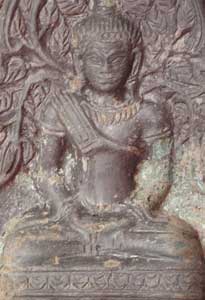Khmer Mold Depicting the Buddha, 12th Century CE - 13th Century CE
Bronze
5.5
FZ.427b
The Khmer civilization, today embodied by the temples and ruins of Angkor, one of mankind's most astonishing and enduring architectural achievements, flourished from 802-1431 A.D. From the great citadel of...
The Khmer civilization, today embodied by the temples and ruins of Angkor, one of mankind's most astonishing and enduring architectural achievements, flourished from 802-1431 A.D. From the great citadel of Angkor, the kings of the Khmer empire ruled over a vast domain that reached from what is now southern Vietnam to Yunan, China and from Vietnam westward to the Bay of Bengal. The original city was built around the Phnom Bakeng, a temple on a hill symbolizing the mountain that stands in the center of the world according to Hindu cosmology. Successive kings enlarged the city, building other temples devoted to various Hindu deities and large reservoirs used for irrigation, which also symbolized the ocean surrounding the holy central mountain.
The Bayon style of Khmer art flourished under the rule of a wise and powerful monarch, Jayavarman VII. The sculpture became more lifelike, reflecting more of a human ideal of beauty than the monumental art of the previous Brahmanic periods. Bayon works combined a tempered realism with an intense expressiveness. The famous “Angkor smile" dates to this period. The Bayon period was characterized by its allegiance to the Sakyamuni, a temporary religious trend that would only last until the resurgence of Brahmanic sects shortly after the passing of Jayavarman VII. This mold, shaped like a lotus blossom, would have been used to make clay idols for personal use by the middle class. Here, the Buddha is depicted seated upon a throne, resting his hands on his thighs in the Dhyana mudra, the posture of meditation. The leafy foliage above him may represent a tree, suggesting that this image may depict the Buddha meditating under the Bodhi tree. This bronze mold is an intriguing relic of Khmer art. It provides us with rare insight into the artistic process of Khmer sculptors. This mold would have been used to make mass-produced clay sculptures; yet while the clay works were numerous, this bronze mold is unique.
The Bayon style of Khmer art flourished under the rule of a wise and powerful monarch, Jayavarman VII. The sculpture became more lifelike, reflecting more of a human ideal of beauty than the monumental art of the previous Brahmanic periods. Bayon works combined a tempered realism with an intense expressiveness. The famous “Angkor smile" dates to this period. The Bayon period was characterized by its allegiance to the Sakyamuni, a temporary religious trend that would only last until the resurgence of Brahmanic sects shortly after the passing of Jayavarman VII. This mold, shaped like a lotus blossom, would have been used to make clay idols for personal use by the middle class. Here, the Buddha is depicted seated upon a throne, resting his hands on his thighs in the Dhyana mudra, the posture of meditation. The leafy foliage above him may represent a tree, suggesting that this image may depict the Buddha meditating under the Bodhi tree. This bronze mold is an intriguing relic of Khmer art. It provides us with rare insight into the artistic process of Khmer sculptors. This mold would have been used to make mass-produced clay sculptures; yet while the clay works were numerous, this bronze mold is unique.
